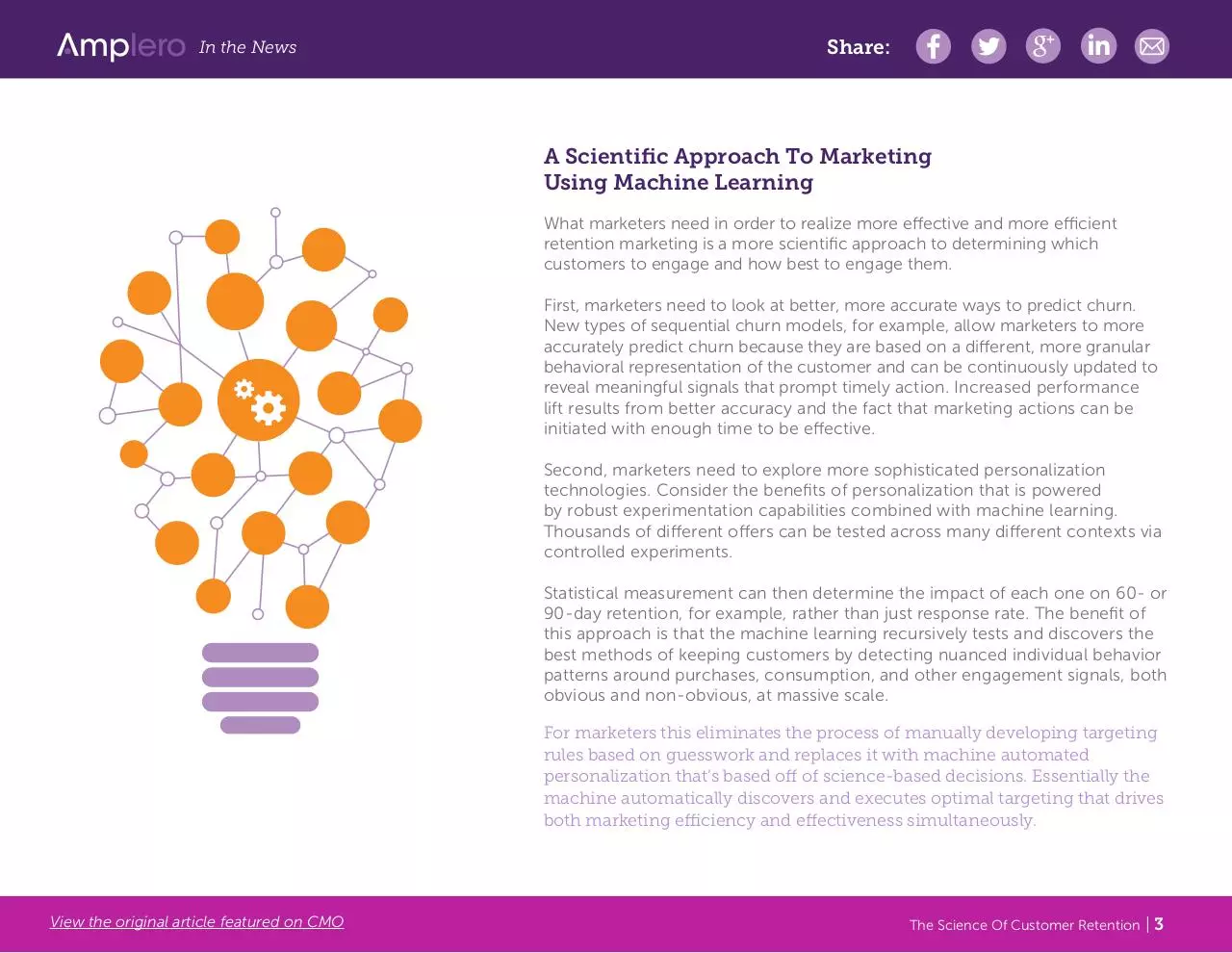Science Customer Retention (PDF)
File information
This PDF 1.7 document has been generated by Adobe InDesign CC 2015 (Macintosh) / Adobe PDF Library 15.0, and has been sent on pdf-archive.com on 17/12/2015 at 20:53, from IP address 71.227.x.x.
The current document download page has been viewed 306 times.
File size: 313.1 KB (4 pages).
Privacy: public file




File preview
In the News
Share:
Article Highlights
The Science Of
Customer Retention
• Are the right retention offers being
targeted to the right customers?
• When it comes to retention
marketing, marketers often do
too much.
• Marketers need a more advanced
personalization capability that uses
machine learning.
by Lara Albert
VP Of Global Marketing
Amplero
Even with all the metrics and sophistication of today’s marketing tools, marketing leaders often have a difficult time quantifying the ROI of a
campaign. In many cases marketers still have to make an educated guess as to whether their retention marketing campaigns, in particular,
could have produced more lift or could have been less costly to execute–or both.
And while every marketer knows that retaining existing customers is cheaper than acquiring new ones, hefty costs are still associated with
many of the marketing tactics used to retain valuable customers.
View the original article featured on CMO
The Science Of Customer Retention
|1
Share:
In the News
Retention marketing that achieves high,
measurable return on investment relies on
two things:
• Making sure that retention tactics are
focused on the right customers
• Delivering to those right customers the
right offers.
Consider the following scenarios:
• A casino offers you a coupon for free slot
play redeemable at your next visit.
• A mobile operator offers you a new phone
to sign on for another year.
• A hotel chain offers you a room upgrade to
book this month.
These types of offers are common for
attempting to increase engagement and boost
retention. But when the focus is on return on
investment, some questions come to mind:
Are retention offers being targeted to the right
customers? And for each target customer, are
we determining the optimal offer?
When it comes to retention marketing,
marketers often do too much. They cast
their nets too wide, targeting offers to
customers who aren’t at real risk of leaving.
And they make offers that they don’t need to
make, giving deals, discounts, and bonuses
to customers who eventually leave anyway
or who would have otherwise stayed.
View the original article featured on CMO
Two Issues Predicting Churn
And Making The Right Offer
So what are the major issues preventing
marketers from maximizing the return on
their retention marketing investments?
They are unable to accurately predict
1. who is going to leave and when:
The reality is that accurately predicting
which customers are at risk of leaving
is difficult even despite state-of-the-art
churn modeling techniques. This is because
traditional churn models rate customers with
a “churn score” that depends on a highly
manual and time-intensive process during
which marketers create aggregate attributes
in a data warehouse.
Because of the way customers are
represented with a traditional data
warehouse approach, granular signals that
indicate customers may leave are frequently
lost. Furthermore, since marketers typically
update customer churn scores only once
or twice per month, customer signals that
emerge faster than that aren’t taken into
account. For marketers, this means having to
execute retention offers based on inaccurate
and untimely customer predictions.
2. They can’t run enough tests to
determine the optimal offer: What
every marketer wants is the ability to
determine for each customer in any given
context the offer that achieves the
perfect balance between effectiveness
and efficiency.
Yet testing and analyzing offers is a
manual process, one that can take several
months and is not capable of scaling to
achieve true one-to-one personalization
across a large customer base. As a result
of the process, only so many variants
can be tested and many options are left
unexplored.
At the same time, marketers tend to
measure the success of campaigns
according to response rate. The more
people who respond to the offer, the more
successful the campaign is. But even if
the response rate is high, marketers don’t
know whether they could have offered
something less; or could have provided
a different type of message instead of an
offer; or if certain offers are better for
some customers and not others; or which
offers were cannibalistic; or whether other
offers could have resulted in more lift, etc.
The Science Of Customer Retention
|2
In the News
Share:
A Scientific Approach To Marketing
Using Machine Learning
What marketers need in order to realize more effective and more efficient
retention marketing is a more scientific approach to determining which
customers to engage and how best to engage them.
First, marketers need to look at better, more accurate ways to predict churn.
New types of sequential churn models, for example, allow marketers to more
accurately predict churn because they are based on a different, more granular
behavioral representation of the customer and can be continuously updated to
reveal meaningful signals that prompt timely action. Increased performance
lift results from better accuracy and the fact that marketing actions can be
initiated with enough time to be effective.
Second, marketers need to explore more sophisticated personalization
technologies. Consider the benefits of personalization that is powered
by robust experimentation capabilities combined with machine learning.
Thousands of different offers can be tested across many different contexts via
controlled experiments.
Statistical measurement can then determine the impact of each one on 60- or
90-day retention, for example, rather than just response rate. The benefit of
this approach is that the machine learning recursively tests and discovers the
best methods of keeping customers by detecting nuanced individual behavior
patterns around purchases, consumption, and other engagement signals, both
obvious and non-obvious, at massive scale.
For marketers this eliminates the process of manually developing targeting
rules based on guesswork and replaces it with machine automated
personalization that’s based off of science-based decisions. Essentially the
machine automatically discovers and executes optimal targeting that drives
both marketing efficiency and effectiveness simultaneously.
View the original article featured on CMO
The Science Of Customer Retention
|3
In the News
Share:
About Lara Albert
Efficiency + Loyalty Increases ROI
The key to keeping customers engaged and building customer loyalty rests
largely on being able to deliver a personalized customer experience. Providing
relevant offers and messages that are tailored to the needs of individuals
translates into good will toward your brand.
But success is not performance lift at any cost.
To achieve exceptional return on retention marketing investment,
marketers must have the ability to continually test and fine-tune at massive
scale – and measure the impact of what is being executed and spent to
save customers.
In past years, personalization for the purpose of saving customers was
impossible at large scale, but today companies have the technology to get to
true one-to-one personalization for millions of customers. Machine automated
technologies exist for not only monitoring and analyzing dynamic behavioral
data to reveal important predictive signals, but also for determining among
thousands of options how best to engage a customer to provide a better
customer experience.
Customer retention is an investment. To maximize their return on that
investment, marketers need to champion the need for data-driven
technologies that make use of machine learning to drive better results.
Lara Albert is VP of global
marketing at Amplero, a selflearning personalization
platform built by Globys.
Benefits of machine learning:
• Never manually create targeting
rules again
• Test thousands of customer
experiences via controlled experiments
• Automate discovery of optimal
targeting conditions
• Achieve continuous optimization via
closed loop learning
• Realize a massive increase in
granularity and results
See Amplero In Action!
Request a Demo
View the original article featured on CMO
The Science Of Customer Retention
|4
Download Science Customer Retention
Science_Customer_Retention.pdf (PDF, 313.1 KB)
Download PDF
Share this file on social networks
Link to this page
Permanent link
Use the permanent link to the download page to share your document on Facebook, Twitter, LinkedIn, or directly with a contact by e-Mail, Messenger, Whatsapp, Line..
Short link
Use the short link to share your document on Twitter or by text message (SMS)
HTML Code
Copy the following HTML code to share your document on a Website or Blog
QR Code to this page

This file has been shared publicly by a user of PDF Archive.
Document ID: 0000324894.